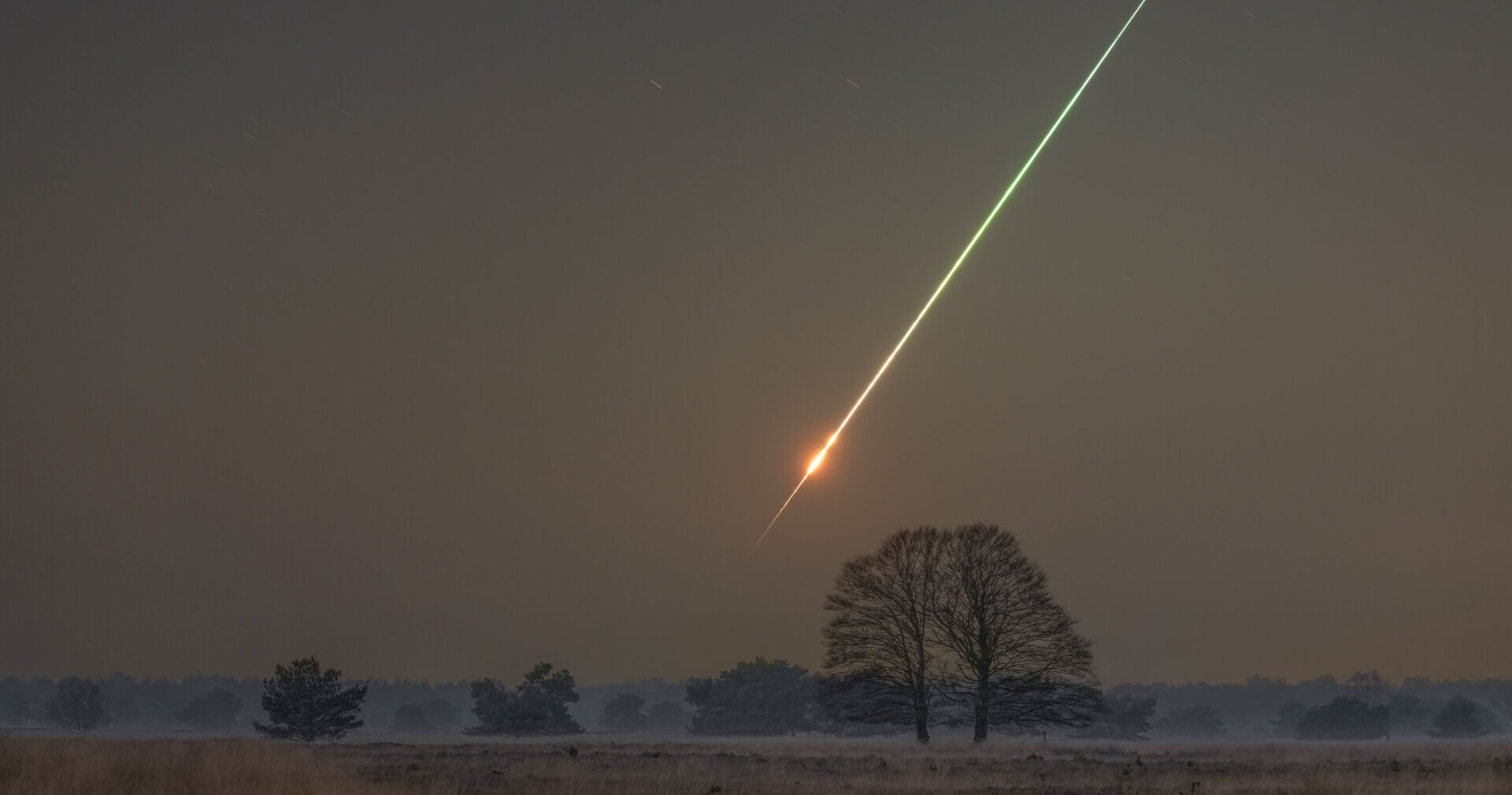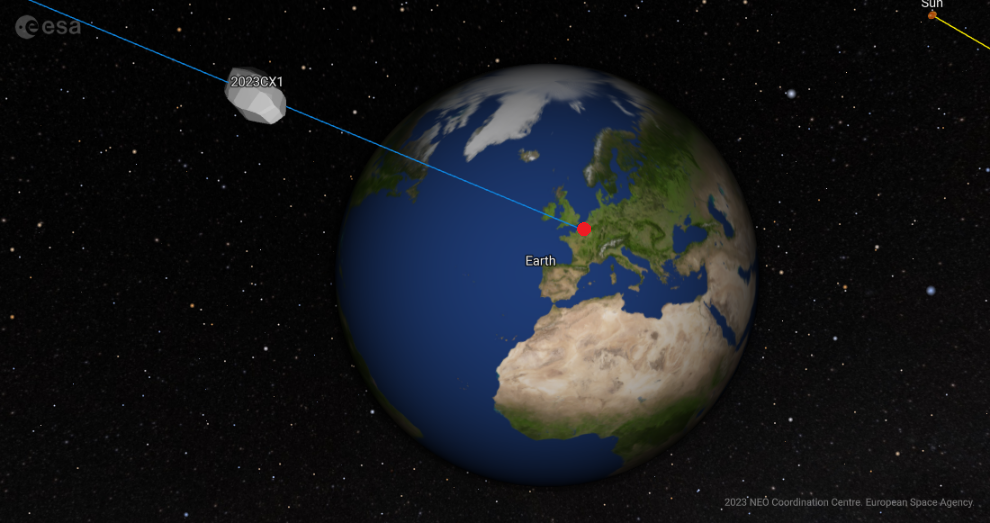A research team led by Auriane Egal from Western University in Ontario, Canada, describes the details that could be determined about the explosion of asteroid 2023 CX1 in February 2023 in the journal Nature Astronomy. The Thuringian State Observatory is involved in this important publication.
On February 12, 2023, Krisztián Sárneczky discovered an asteroid at the Konkoly Observatory in Hungary. The asteroid, named "2023 CX1", had a diameter of just under one meter and an estimated mass of about 650 kilograms. Seven hours after it was first sighted, it exploded over Normandy in France. Now, an international team of researchers has published a comprehensive study on it.
 Landscape photographer Gijs de Reijke captured this spectacular image of fireball 2023 CX1 over northern France as the meteor broke up and vaporized. Photo: Gijs de Reijke2023 CX1 is one of the very rare cases of a cosmic object being discovered before it entered Earth's atmosphere. This made it possible to track its path from space until it impacted Earth. Using new and innovative observation strategies, the European Space Agency (ESA) and the US space agency NASA were able to predict the time and the location of the fall of 2023 CX1 with unprecedented accuracy. Dutch landscape photographer Gijs de Reijke managed to capture a spectacular image of the meteor shortly before it broke apart over Normandy.
Landscape photographer Gijs de Reijke captured this spectacular image of fireball 2023 CX1 over northern France as the meteor broke up and vaporized. Photo: Gijs de Reijke2023 CX1 is one of the very rare cases of a cosmic object being discovered before it entered Earth's atmosphere. This made it possible to track its path from space until it impacted Earth. Using new and innovative observation strategies, the European Space Agency (ESA) and the US space agency NASA were able to predict the time and the location of the fall of 2023 CX1 with unprecedented accuracy. Dutch landscape photographer Gijs de Reijke managed to capture a spectacular image of the meteor shortly before it broke apart over Normandy.
As many aspects as possible examined
More than 100 scientists, including meteorite physicists and amateur observers from Europe, America, Africa, and Australia, have joined forces to investigate all aspects of this extraordinary event: discovery with telescopes, tracking of the orbit, atmospheric observations using optical, infrasound, and seismic data, and geochemical laboratory analyses. Their findings are summarized in the article "Catastrophic disruption of asteroid 2023 CX1 and implications for planetary defense", published in September 2025 in Nature Astronomy. The Thuringian State Observatory is part of the author team.
 Trajectory of Asteroid 2023 CX1. Source: ESA NEO2023 CX 1 shattered around 28 kilometers above the Earth – and not just upon impact with the Earth's surface. It released 98 percent of its energy in a fraction of a second. The explosion scattered more than a hundred fragments over Normandy. Since the location and time were known, researchers set out to search for remnants of the asteroid. And indeed, they found what they were looking for. Small fragments of the meteorite were then examined in the laboratory.
Trajectory of Asteroid 2023 CX1. Source: ESA NEO2023 CX 1 shattered around 28 kilometers above the Earth – and not just upon impact with the Earth's surface. It released 98 percent of its energy in a fraction of a second. The explosion scattered more than a hundred fragments over Normandy. Since the location and time were known, researchers set out to search for remnants of the asteroid. And indeed, they found what they were looking for. Small fragments of the meteorite were then examined in the laboratory.
Explosion with great force
The asteroid exploded so quickly and with such force that its behavior highlights the potential danger of similar – and larger – astronomical objects. That is why the analysis of asteroid 2023 CX1 represents a unique opportunity for science, but also for protecting Earth from asteroids. Auriane Egal, professor at Western University in Ontario, Canada, and lead author of the article, says: "We have confirmed the existence of a new population of asteroids associated with L-type chondrites that are capable of breaking up abruptly in the atmosphere and releasing almost all of their energy at once. Such asteroids must be taken into account in strategies to protect Earth, as they pose an increased risk to populated areas."
Thuringian State Observatory operates a meteor camera
Since 2010, the Thuringian State Observatory has been participating in the classification and monitoring of near-Earth objects with its 2-meter Alfred Jensch telescope. It operates a meteor camera as part of a larger network of such observation instruments for asteroids and minor planets.
Continuous measurements of the celestial position of newly discovered and known near-Earth asteroids increase the accuracy of their orbits. This makes it easier to assess whether a new object is close to Earth or not, or whether the danger posed by a known asteroid has decreased or increased. With an average of 6,000 measurements per year, the TLS is now one of the most productive observatories in Europe in this field.
Links
News Release, Western University
ESA Near-Earth Objects Coordination Center
Asteroid 2024 BX1 observed at the TLS shortly before its impact near Berlin
Background Information: What is an airburst?
What happens to an asteroid when it enters the Earth's atmosphere at high speed depends on how big it is. The celestial body heats up so much due to friction that it vaporizes on the surface. Bodies smaller than a few centimeters vaporize completely. Bodies larger than 10 meters remain intact and strike the Earth.
In the size range in between, the following occurs: The surface of the celestial body reaches temperatures of 2000 to 3000 degrees Celsius, while the center remains at around -70 degrees Celsius. This creates thermal stresses that cause the asteroid to burst apart – just as glass shatters when it is suddenly heated to a high temperature. The resulting fragments give the atmosphere a larger surface area to attack, which intensifies the process. The technical term for this phenomenon is "airburst."

